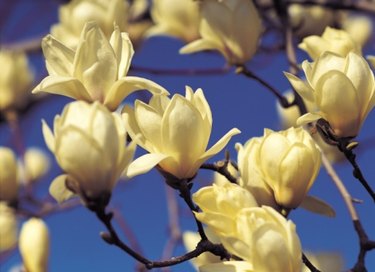
The Little Gem magnolia (Magnolia grandiflora 'Little Gem,' USDA hardiness zones 5-9) is a small, adaptable, evergreen tree. Like other magnolia trees, it has dark green leaves and white, fragrant flowers. But as it's name suggests, it's a dwarf magnolia; a smaller version of the species that grows only 20 feet tall to the potential 80 feet height of the species.
In general, Little Gem magnolias are low-maintenance trees with no serious pest or disease problems. However, Cal Poly's Urban Forest Ecosystems Institute notes that they are susceptible to a few pests, such as aphids, scale insects and spider mites. A handful of diseases caused by fungal or bacterial pathogens may also be troublesome. In addition, Little Gems are prone to root girdling and injuries to their relatively thin bark. In most cases, these trees should present few problems to growers. When problems do occur, chemical control is generally not warranted.
Video of the Day
Video of the Day
Little Gem Magnolia Diseases
Little Gem magnolias may become infected with blight, canker, black mildew and leaf spot, particularly if conditions that favor the formation of these diseases are present. Trees will experience these problems most frequently and severely in areas with high humidity, light frequent rain or irrigation, heavy dew and dense plantings.
In general, these diseases usually produce more visual than physical injury to the affected tree. To discourage the spread of disease, redirect sprinklers to avoid direct leaf spray and regularly prune dead branches. Also, consistently rake and dispose of any infected leaves. Remove branches with cankers, because the cankers will eventually kill branches. The University of Florida IFAS Extension recommends keeping trees fertilized and watering them during dry periods to keep them healthy and better able to withstand diseases.
Little Gem Magnolia Pests
A few of the more common forms of pests that are known to attack Little Gem magnolia include aphids, magnolia scale, and spider mites. Scale insects will infest both twigs and leaves, causing reduced leaf and flower production. Overall, young, less vigorous trees in poor health are most prone to insect infestation. Discourage infestation by providing cultural conditions and nutrients that keep trees healthy. Look for clear indications of infestations. Apply insecticide, if necessary, during times of the year when pests are most prevalent.
Other Little Gem Magnolia Problems
Girdling Roots
All types of magnolia trees are prone to girdling, which is a condition that causes the roots of the trees to circle the trunk. Unfavorable conditions that prevent roots from spreading, such as growth in a container or compact soil, are thought to encourage girdling. Before planting a Little Gem magnolia, check the root ball for any circling.
It is best to slash the circling roots vertically with a knife in several places before placing it in the ground. This will loosen roots and encourage their development outward away from the tree. Re-inspect trees when trunks are about 6 inches in diameter. If root girdling is not corrected, trees will likely weaken and die over a period of 5 to 20 years.
Soft Bark
All types of magnolias are relatively soft-wooded, with thin, easily damaged bark. Consequently, they can be seriously damaged by lawn mowers and weed trimmers. Magnolias are most vulnerable in the early spring and early fall months while the bark is most loose due to cambium growth.
Wounds can allow pathogens to enter a tree and quickly spread to nearby healthy plant tissue. Protect trees by suppressing grass and weeds underneath the canopy with a layer of mulch, which eliminates the need for using a mower and string trimmer near the tree trunk.